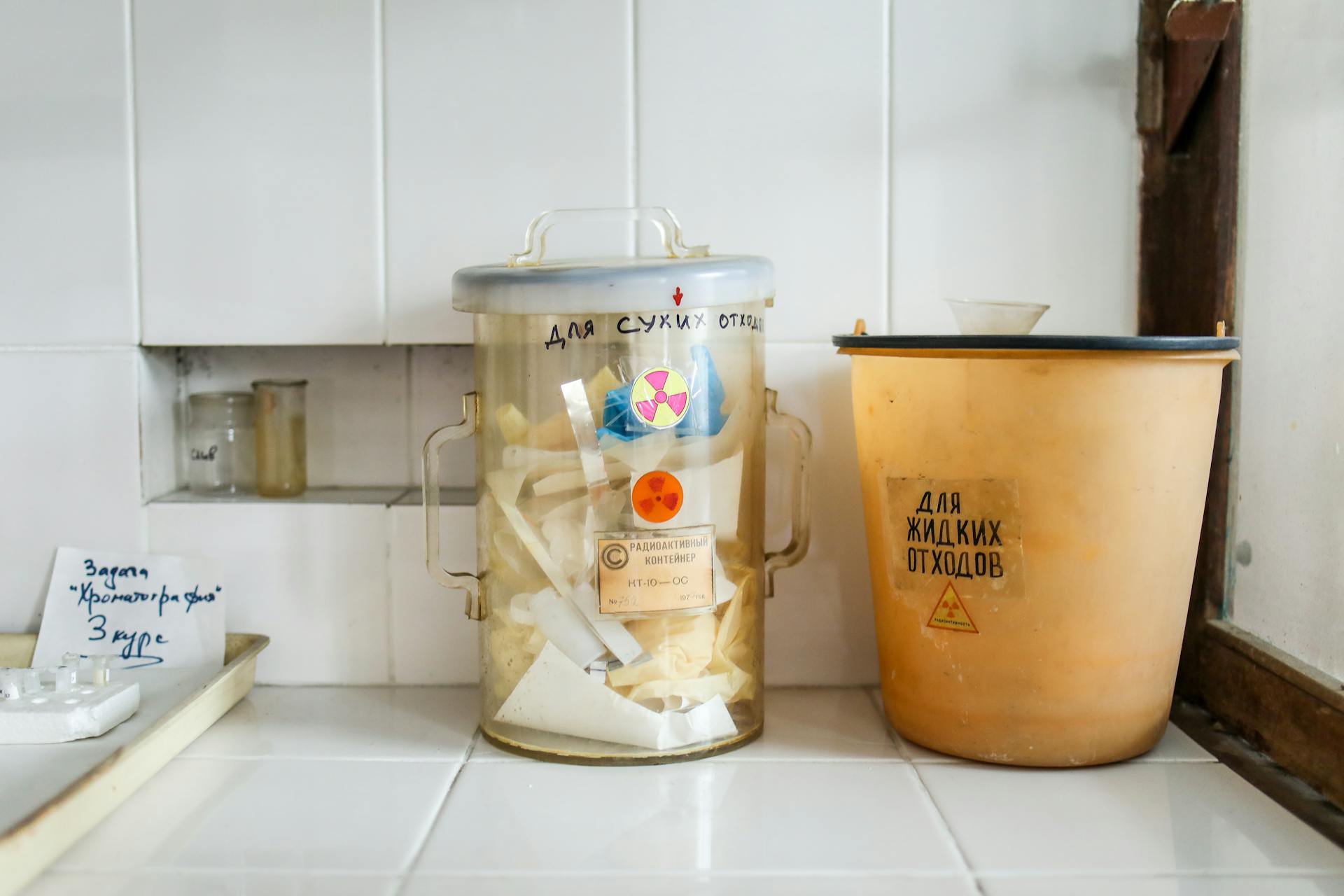
Antifreeze dog poison symptoms can be a real concern for pet owners. Exposure to ethylene glycol, the main ingredient in antifreeze, can be toxic to dogs.
Antifreeze is often left out in the open or stored in areas where pets can access it, making it a common source of poisoning. This can happen even if the pet only licks a small amount of antifreeze.
If your dog ingests antifreeze, it's essential to recognize the symptoms, which can appear within 30 minutes to 12 hours after exposure. These symptoms can range from mild to severe and may include vomiting, diarrhea, lethargy, and abdominal pain.
Dogs with kidney failure may exhibit more severe symptoms, such as increased thirst and urination, and may even go into a coma.
What Is Ethylene Glycol?
Ethylene glycol is a sweet-tasting, odorless liquid.
It's commonly found in automotive antifreeze products, which is why it's essential to keep these products out of reach of your furry friends.
Ethylene glycol can also be found in lower concentrations in some windshield de-icing agents.
This means that even if you're using a product labeled as safe, it's still crucial to double-check the ingredients.
In fact, ethylene glycol is used in a wide range of products, including hydraulic brake fluid, motor oils, solvents, paints, film processing solutions, wood stains, inks, and printer cartridges.
Causes and Stages
Antifreeze poisoning in dogs can occur within 30 minutes to 12 hours after ingestion, which is a relatively short time frame. This is why it's crucial to keep a close eye on your dog's behavior and health during this period.
The first stage of antifreeze poisoning is characterized by lethargy, depression, lack of coordination, vomiting, diarrhea, increased thirst, and urination. Some dogs may also experience seizures or comas during this stage.
Here are the stages of dog antifreeze poisoning symptoms:
- Stage 1: Occurs within 30 minutes to 12 hours after ingestion, with symptoms like lethargy, vomiting, and increased thirst and urination.
- Stage 2: Symptoms worsen and can include seizures and comas.
Hypothermia, or low body temperature, is also a common symptom of antifreeze poisoning in dogs.
Stage 1

Stage 1 of antifreeze poisoning in dogs can be a critical period, and it's essential to recognize the signs quickly. The first stage occurs within 30 minutes to 12 hours after ingestion.
Your dog might show lethargy, depression, and lack of coordination, which can manifest as staggering. Dog vomiting and diarrhea are also common symptoms during this stage.
Some dogs may experience seizures or even enter comas during this stage. Increased thirst and drinking, as well as increased urination, are other signs to look out for.
Hypothermia, or low body temperature, can also occur during the first stage of antifreeze poisoning. If you suspect your dog has ingested antifreeze, it's crucial to seek veterinary care immediately.
Readers also liked: Poison Dog Signs
Stage 3
At this stage, your dog's kidneys will show severe deterioration, making it hard for them to produce urine.
Their swollen kidneys can cause very little pee or none at all to come out when they try to go to the bathroom.
The symptoms you saw earlier, like lack of appetite and lethargy, may reappear.
You might also notice vomiting.
In the final hours, your dog could suffer seizures or a coma.
Sadly, many dogs who progress to this stage will die.
Symptoms and Effects
Dogs will become lethargic and weak 30 minutes after consuming antifreeze.
Excessive urination and thirst are common symptoms, often accompanied by vomiting and seizures. In the first half-hour, dogs may vomit a lot and seem wobbly on their feet.
Low body temperature can come on suddenly, and multiple seizures may occur during this time frame.
If you suspect your dog has ingested antifreeze, bring them to the emergency vet right away.
After the 12-hour mark, the symptoms may seem to improve, but this is a false sense of security - the dog is actually getting much worse.
Dogs may have a significantly elevated heart rate and difficulty breathing at this point, and are usually highly dehydrated.
Seizures may worsen again 3 to 6 days after consuming antifreeze, and dogs may go into a coma or suffer from extreme dehydration.
The kidneys may be swollen so much that they are visible under the skin, and will go into kidney dysfunction or failure soon after.
Excessive thirst and urination are symptoms of antifreeze poisoning, often mistaken for diabetes in dogs.
Dogs will become confused and disoriented within the first half hour of ingesting antifreeze, stumbling and falling easily.
Ethylene glycol poisoning is divided into three stages, with the first stage occurring within 30 minutes of ingestion, characterized by lethargy, vomiting, incoordination, and excessive urination.
Dogs must be treated within 8-12 hours of ingesting antifreeze, as the antidote only has a short timeframe to work.
Diagnosis and Treatment
If you suspect your dog has ingested antifreeze, it's essential to get them to the vet right away. The vet will start treatment with an antifreeze antidote while waiting for confirmation from diagnostic tests.
The best way to confirm antifreeze poisoning is to measure the concentration of the chemical in your dog's blood. This test can be done at some veterinary diagnostic laboratories or human hospitals and is very accurate, but many local animal hospitals may not have it.
Discover more: Vets Dog Treats
Your vet might use test strips to detect ethylene glycol in the blood, but these strips aren't always accurate and can deliver false positives or negatives. If kidney failure has occurred, urinalysis and blood tests can confirm the damage, but by then it may be too late for the antidote to be effective.
Antidotes, such as fomepizole or ethanol, are administered along with intensive intravenous fluids and other medications to combat nausea and vomiting. Your vet will also monitor your dog's electrolyte levels, blood pH, and urine production.
It's crucial to seek immediate veterinary attention if you suspect your dog has ingested antifreeze, as the prognosis is very poor once clinical signs have developed.
How Veterinarians Confirm
Veterinarians use blood tests to confirm ethylene glycol poisoning, measuring the blood concentration of ethylene glycol for accuracy.
These tests can be performed at some veterinary diagnostic laboratories or human hospitals, but may not be available in the middle of the night.
Some veterinary hospitals have an in-house test kit that can detect the presence of ethylene glycol in the bloodstream, but these tests may not be as accurate and can result in false positives.
False positives can occur due to exposure to other alcohols, such as propylene glycol, glycerol, mannitol, isopropyl alcohol, sorbitol, etc.
To ensure accuracy, the test should be performed within 6 hours of exposure, or it could result in a false negative.
Peak levels of ethylene glycol are detected in the first 1–6 hours after ingestion of the toxin, making early testing crucial.
By as early as 24 hours after ingestion, insufficient ethylene glycol remains to allow detection on this blood test, and the damage to your pet's body has already occurred.
A urinalysis may also confirm ethylene glycol poisoning and underlying kidney damage, but these tests are not specific for ethylene glycol poisoning.
A special black-light lamp, known as a Wood's lamp, can sometimes be used to examine the urine, muzzle, and paws of the patient to look for the presence of the warning dye added to automotive antifreeze.
How Is Treated?

If your vet suspects antifreeze poisoning, they will start treatment with an antifreeze antidote while waiting for confirmation from diagnostic tests.
The antidote used is either fomepizole or ethanol, and intensive intravenous fluids are administered along with the antidotes.
Your vet will also give your dog other medications to combat nausea and vomiting, as well as supportive care.
Monitoring your dog's electrolyte levels, blood pH, and urine production is crucial in treating antifreeze poisoning.
It's essential to seek immediate veterinary attention if you suspect your dog has ingested antifreeze, as the prognosis is very poor once clinical signs have developed.
Emergency vets can give pets an antidote that significantly reduces the risk of death from antifreeze poisoning, but it's crucial to get your pet to the vet within a few hours of ingestion.
For cats, treatment should start within 3 hours of ingestion, while dogs should be treated ideally within 8 hours, but up to 12 hours after ingestion.
Suggestion: Treatment for Dog Poisoned by Rat Poison
Frequently Asked Questions
How fast will antifreeze make a dog sick?
Symptoms of antifreeze poisoning in dogs can appear within 12 hours, but kidney failure and severe illness can develop 2-3 days after ingestion. If you suspect your dog has ingested antifreeze, seek veterinary attention immediately.
What are the three stages to ethylene glycol poisoning?
Ethylene glycol poisoning has three stages: the neurological stage (0-12 hours), cardiopulmonary stage (12-24 hours), and renal stage (24-72 hours). Understanding these stages is crucial for prompt medical treatment and survival.
Sources
- https://vcahospitals.com/know-your-pet/ethylene-glycol-poisoning-in-dogs
- https://www.akc.org/expert-advice/health/antifreeze-poisoning-in-dogs/
- https://emergency.thevillagevets.com/blog/dog-antifreeze-poisoning-symptoms/
- https://evcc.com/blog/symptoms-of-antifreeze-poisoning-in-dogs/
- https://heartandpaw.com/pet-parent-resources/antifreeze-poisoning-in-dogs
Featured Images: pexels.com


